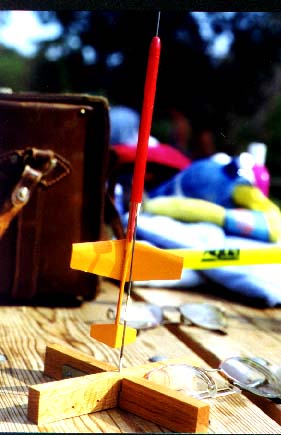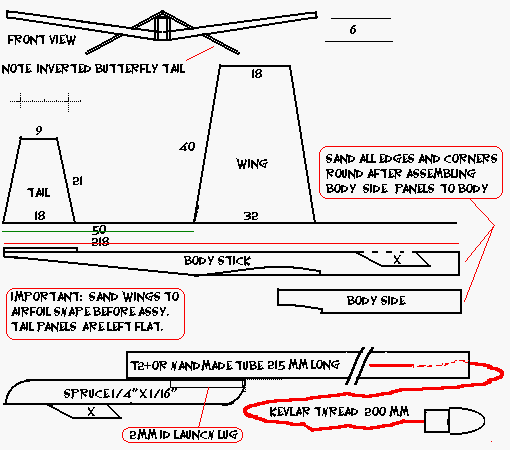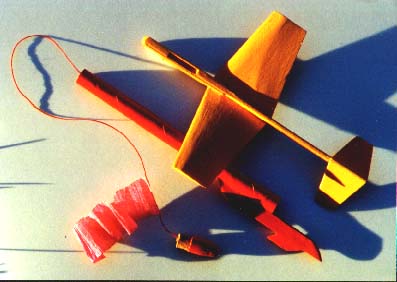Descon Flake Boost-Glider Original Design / Scratch Built
Scratch - Flake Boost-Glider {Scratch}
Contributed by Peter Clay
 This is a simple scale-down of a time-tested, already small glider. It boosts to about 40 feet and in two flights has glided about 6 seconds each time.
This is a simple scale-down of a time-tested, already small glider. It boosts to about 40 feet and in two flights has glided about 6 seconds each time.
Materials:
Body Tube: Totally Tubular T2+ would be ideal. Prototype is a hand-rolled spiral tube. About 215mm long, i.d. a bit over 6mm.
Pylon and Piece-X: Aircraft spruce, 1/16 x 1/4"
Launch Lug: Hand rolled around a piece of music wire slightly larger than the rod
Launch Rod: 1/16" music wire 18" long (QMM silo rod just isn't long enough)
Shock Cord: Kevlar® thread would be good. Prototype uses button and carpet thread. OK so far.
Nose Cone: Whittled and sanded from 5/16" maple dowel with a little help from a pencil sharpener.
Streamer: 1/2" x 3-1/2" (13x180mm) crepe paper, held to shock cord with a bit of glue
Body Stick and Wings: 3/32" (2mm) medium balsa
Body Side Panels and Tail Panels: 1/32" (1mm) light balsa
yellow glue and masking tape, modeling knife
Construction:
- Use illustration to make patterns for all parts. If original GIF art is posted (it is - ed.), it should print out actual size on most printers.
- Trace and cut out all parts. Cut Piece-X from glider body and discard. Glue side panels to both sides of nose to create a pocket.
- Sand all edges and corners of body stick round EXCEPT lower edge where wings will glue on. Slightly round edges of tail panels. Bevel root edges of tail panels about 20 degrees. Bevel root edges of wing panels about 5 degrees. Use a sanding block for this.
- Carve the top surface only of the wings into a lifting airfoil, rounded at the front, tapered to a thin trailing edge.
- Glue the two tail panels together on the beveled edges so they make about a 40 degree angle. Set aside to dry.
- Set the body stick on a sheet of waxed paper on a flat surface. Glue the wings on so that the trailing edge of the wing is 2" / 50mm from the tail end.
- Support each wingtip with a pencil until glue dries.
- Apply a bead of glue to the top surface of the body stick at the tail end.
- Drape the glued, dried tail over it so the panels hang down at a 20 degree angle on each side. Let dry.
- Carve the piece-x and pylon pieces out of the spruce stick. Make sure the piece-x fits loosely in the glider's pocket. Glue the piece-x to the pylon
- about 1/2" / 13mm from the back. Let dry.
- Glue the forward half of the pylon to the aft end of the body tube. It should extend 1-1/4" or 31mm behind the body.
- Make a launch lug from a 1/2" / 13mm square piece of shiny magazine paper,
- rolling it around the launch rod and gluing all except the bottom layer. Let dry.
- Glue the launch lug into the joint between the body tube and pylon.
- To anchor the shock cord: Punch a small hole 20mm =/- from the forward end of the tube. Pull 1/2" or 13mm of the shock cord through the hole from the inside outward. Glue it to the outside of the tube.
- Drill a small hole in the nose cone. Fill it with glue and stuff the free end of the shock cord in. Let dry.
- Apply glue to a narrow strip at the very end of the streamer. Fold 1/8" / 3mm of the streamer around the shock cord and glue it.
- Fillet all joints with yellow glue and let dry.
- Apply one coat of sanding sealer over the entire glider and sand lightly.
Follow with one light coat of spray paint for color. Don't overdo it. Too much paint is too much weight.

Hand Tossing the Flake:
Your glider should stall slightly when tossed. If it doesn't, twist both tail surfaces (downward in the front) a bit until it does.
Once it is stalling lightly, apply a small amount of masking tape to the underside of the nose to balance it.
Flying the Flake:
Use a Quest Micro Max motor. Friction fit with masking tape. Cut a strip of tape 1/8" / 3mm wide and wrap it around the nozzle end to serve as a thrust ring. Insert the motor. Loosely wad 3 square inches (25x75mm) of ordinary Estes-type recovery wadding and pack it loosely in front of the motor. Fold the streamer until it can be fitted into the tube, insert it. Finally pack the remaining shock cord and insert the nose cone. Place the pod on the rod and check to see how high up it has to be to support the glider off the pad. Tape your launcher leads to the rod so the clips are at that level and cannot flop enough to catch on the glider's wings or tail. Pry apart the two halves of the ignitor block and remove the ignitor. Insert it into the motor. Place the pod on the rod and hook up the ignitor. Hang the glider on the pylon by its piece-x. It should fit loosely but settle against the pylon by gravity due to the angle of the piece-x hook. If there is enough wind to blow the glider off the hook, be very cautious when launching. The pod is not stable without the glider.

Countdown and let 'er rip!
 |
 |